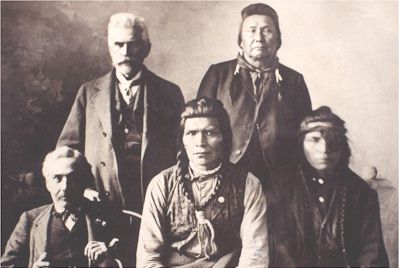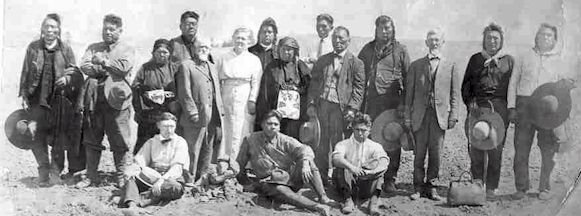1400 Mile Retreat
Contributed by Jim Reavis
On July 17, 1877, the famous retreat of Chief Joseph began, followed by the troops of General O. Howard. The thrilling story of this retreat written by some gifted Indian, would sound mush like Xenophon’s story of “Retreat of the One Thousand’. General Howard and stampeded his pack train, which was partially recovered later by the cavalry. “The fleeing Indians then traveled some of the worst trails for man or beast on this continent,” as described by General Sheridan. On September 13, they gave battle to General Sturgis near the mouth of Clark’s Fork. “The Indians proceeded north toward the British possessions with the view of joining the renegade Sioux with whom Sitting Bull was in hiding.” The Indians, who had successfully retreated a thousand miles, crossed the Missouri river, and at the mouth of Eagle creek in the Bear Creek mountains, within fifty miles of the British possessions, were attacked by General Miles.
As the fight was closing, (September 30) General Howard came up and the entire band of Indians surrendered to him and General Miles. “This”, said General Sheridan, “ended one of the most extraordinary Indian wars of which we have any record,” The Indians throughout displayed a courage and skill that elicited universal praise: they abstained from scalping: let captive women go free: did not commit indiscriminate murder of peaceful families, which is unusual: and fought with almost scientific skill. After the war the Nez Percé were sent to Indian territory where they were peaceable and industrious; and May 1885, they returned to Idaho and Washington; but they were never again permitted to live in the Wallowa valley for which the Nez Perce war was fought. September 21, 1904, Chief Joseph died at the age of 67, at his lonely place of exile at Nespelem on the Colville Indian reservation. Washington, surrounded by a small band of his intimate friends. A splendid monument erected by the State of Washington now marks his grave.
Chief Joseph's Last Visit
 |
August 5, 1899 during Chief Joseph's last visit to Wallowa County in his attempt to secure space for his people. Top, left to right Inspector James McLaughlin, Indian Agent (the same agent that sent the Indian Police to arrest Sitting Bull, resulting in his death), Chief Joseph. Bottom row: Edward Rabain, government interpreter, Peo Peo Tholekt (Landing Bird), a minor Nez Perce chief and Phillip Andres also a minor chief. |
| .
Chief Joseph Descendants |
|
|
|
Old Chief Joseph This picture was taken about 40 years ago near
the Wallowa river between Lostine and Wallowa on the
occasion of the removal of the remains of Old Chief
Joseph to the cemetery at the foot of Wallowa lake. The
bones of old chief, father of Chief Joseph who led the
Nez Percé in the wars of
the 1870's. The Indians shown here are descendants of
Chief Joseph who assisted in locating the remains which
were with the remains of several other Indians in a
burial plot which had been plowed up in farming
operations. The three white people in the picture, from
left to right, are: Jim Tulley, a pioneer resident of
the county, Mrs. Anna Reavis, daughter of A. C. Smith,
another pioneer and close friend of Chief Joseph and a
member of his tribe, and W. W. White. Mrs. Reavis, 89,
still makes her home in Enterprise. After the remains
had been gathered up a big ceremony was held at Wallowa
lake in connection with the re-burial rites. One of the
Indians pictured would be
Chief Yellow Bull
as he spoke at the ceremony. |
